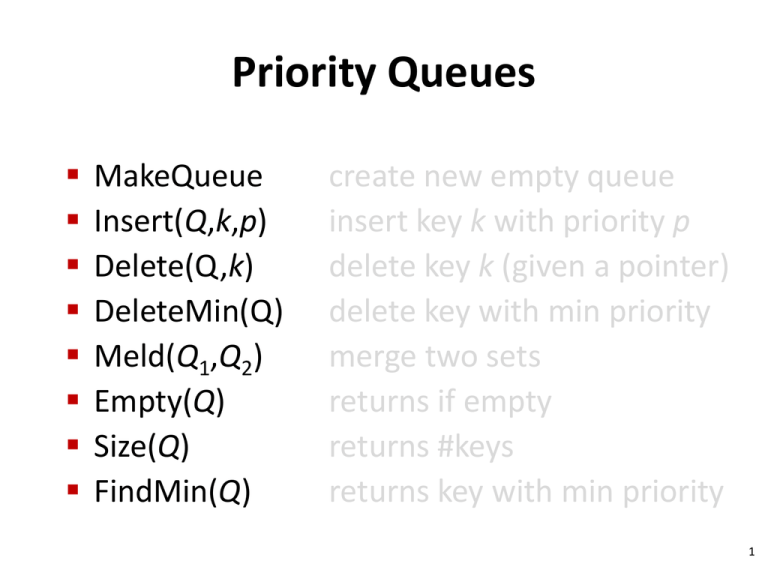pptx - Department of Computer Science
advertisement

Priority Queues
MakeQueue
Insert(Q,k,p)
Delete(Q,k)
DeleteMin(Q)
Meld(Q1,Q2)
Empty(Q)
Size(Q)
FindMin(Q)
create new empty queue
insert key k with priority p
delete key k (given a pointer)
delete key with min priority
merge two sets
returns if empty
returns #keys
returns key with min priority
1
Priority Queues – Ideal Times
MakeQueue, Meld, Insert, Empty, Size, FindMin: O(1)
Delete , DeleteMin: O(log n)
Thm
Meld O(n1-ε) DeleteMin Ω(log n)
2) Insert, Delete O(t) FindMin Ω(n/2O(t))
1)
1) Follows from Ω(n∙log n) sorting lower bound
2) [G.S. Brodal, S. Chaudhuri, J. Radhakrishnan,The Randomized Complexity of Maintaining the Minimum. In Proc. 5th Scandinavian
Workshop on Algorithm Theory, volume 1097 of Lecture Notes in Computer Science, pages 4-15. Springer Verlag, Berlin, 1996]
2
3
3
2
4
1
6
5
0
5
1
7
2
0
0
1
8
9
0
0
8
Binomial Queues
[Jean Vuillemin, A data structure for manipulating priority queues,
Communications of the ACM archive, Volume 21(4), 309-315, 1978]
0
7
Binomial tree
– each node stores a (k,p) and satisfies heap order
with respect to priorities
– all nodes have a rank r (leaf = rank 0, a rank r node
has exactly one child of each of the ranks 0..r-1)
Binomial queue
– forest of binomial trees with roots stored in a list
with strictly increasing root ranks
3
Problem
Implement binomial queue operations to achieve
the ideal times in the amortized sense
Hints
1) Two rank i trees can be linked to create a rank
i+1 tree in O(1) time
x
r
y
r
link
x≥y
r
x
y
2) Potential Φ = max rank + #roots
r+1
4
Dijkstra’s Algorithm
(Single source shortest path problem)
Algorithm Dijkstra(V, E, w, s)
Q := MakeQueue
dist[s] := 0
Insert(Q, s, 0)
for v V \ { s } do
dist[v] := +∞
Insert(Q, v, +∞)
while Q ≠ do
v := DeleteMin(Q)
foreach u : (v, u) E do
if u Q and dist[v]+w(v, u) < dist[u] then
dist[u] := dist[v]+w(v, u)
DecreaseKey(u, dist[u])
n x Insert + n x DeleteMin + m x DecreaseKey
Binary heaps / Binomial queues : O((n + m)∙log n)
5
Priority Bounds
Binomial
Queues
Fibonacci
Heaps
[Vuillemin 78]
Insert
Meld
Delete
DeleteMin
DecreaseKey
Run-Relaxed
Heaps
[Fredman, Tarjan 84]
[Driscoll, Gabow,
Shrairman, Tarjan 88]
[Brodal 96]
1
1
log n
log n
1
1
log n
log n
1
log n
log n
1
1
log n
log n
log n
1
1
1
Amortized
Worst-case
Dijkstra’s Algorithm O(m + n∙log n)
(and Minimum Spanning Tree O(m∙log* n))
Empty, FindMin, Size, MakeQueue – O(1) worst-case time
6
Fibonacci Heaps
3
3
[Fredman, Tarjan, Fibonacci Heaps and Their Use in Improved Network Algorithms,
Journal of the ACM, Volume 34(3), 596-615, 1987]
1
6
F-tree
2
4
7
0
0
5
0
7
– heap order with respect to priorities
– all nodes have a rank r {degree, degree + 1}
(r = degree + 1 node is marked as having lost a child)
– The i’th child of a node from the right has rank ≥ i - 1
Fibonacci Heap
– forest (list) of F-trees (trees can have equal rank)
7
Fibonnaci Heap Property
Thm Max rank of a node in an F-tree is O(log n)
Proof A rank r node has at least 2 children of rank
≥ r – 3. By induction subtree size is at least 2└r/3┘ □
( in fact the size is at least r , where =(1+5)/2 )
8
Problem
Implement Fibonacci Heap operations with amortized O(1)
time for all operations, except O(log n) for deletions
Hints
1) Two rank i trees can be linked to create a rank
r
r
r
link
x
y
i+1 tree in O(1) time
x
y
r+1
x≥y
2) Eliminating nodes violating order or nodes having
lost two children
y
degree(x) = d ≤ r-2
x
r
d
cut
3) Potential Φ = 2∙marks + #roots
y
x
9
Implemenation of
Fibonacci Heap Operations
FindMin
Insert
Join
Delete
DeleteMin
DecreaseKey
Maintain pointer to min root
Create new tree = new rank 0 node +1
Concatenate two forests unchanged
DecreaseKey -∞ + DeleteMin
Remove min root -1
+ add children to forest +O(log n )
+ bucketsort roots by rank only O(log n ) not linked below
+ link while two roots equal rank -1 each
Update priority + cut edge to parent +3
+ if parent now has r – 2 children,
recursively cut parent edges -1 each, +1 final cut
* = potential change
10
Worst-Case Operations
(without Join)
[Driscoll, Gabow, Shrairman, Tarjan, Relaxed Heaps: An Alternative to Fibonacci Heaps with Applications to Parallel Computation,
Communications of the ACM, Volume 34(3), 596-615, 1987]
Basic ideas
Require ≤ max-rank + 1 trees in forest
(otherwise rank r where two trees can be linked)
Replace cutting in F-trees by having O(log n) nodes
violating heap order
Transformation replacing two rank r violations by
one rank r+1 violation
11







